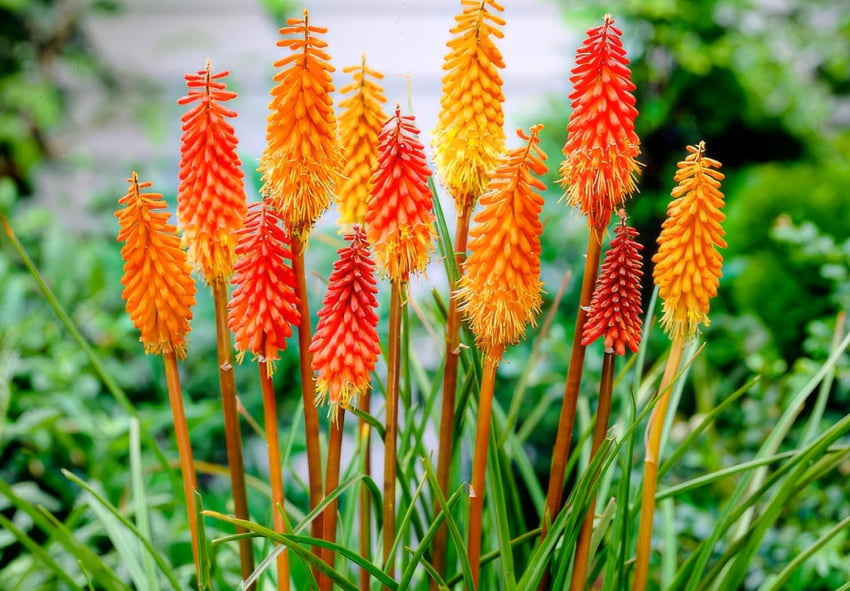Kniphofia, commonly known as Red Hot Poker, is a striking addition to any garden, known for its vibrant, torch-like flowers. Their bright colors and unique structure make them a popular choice for gardeners looking to add a bold, exotic touch to their landscapes. Proper care and maintenance are essential to ensure healthy growth and prolific blooming, making understanding their specific needs crucial for success. Our gardening blog is a perfect place to find all the information you need!
Understanding Kniphofia
Understanding Kniphofia is key to maximizing its potential in your garden. Familiarizing yourself with its varieties, ideal growing conditions, and unique characteristics will help you make informed decisions about where and how to cultivate this captivating plant.
Varieties of Kniphofia
Kniphofia offers a diverse range of varieties, each with distinct characteristics that cater to different aesthetic and environmental preferences. Popular varieties include:
| Variety | Bloom Time | Fragrance | Height | Ideal for Containers | Frost Resistance |
| Kniphofia ‘Flamenco’ | Late Summer | Mild | 2-3 feet (60-90 cm) | Yes | Moderate |
| Kniphofia ‘Nancy’s Red’ | Mid to Late Summer | None | 3-4 feet (90-120 cm) | No | High |
| Kniphofia ‘Little Maid’ | Early to Mid Summer | Mild | 1-2 feet (30-60 cm) | Yes | Low |
| Kniphofia ‘Tawny King’ | Late Summer to Fall | Mild | 3-4 feet (90-120 cm) | No | Moderate |
| Kniphofia ‘Mango Popsicle’ | Mid Summer | None | 1-2 feet (30-60 cm) | Yes | High |
Ideal Growing Conditions
Kniphofia thrives in climates with moderate temperatures, ideally in USDA hardiness zones 5 through 9. These plants prefer well-drained, fertile soil and full sun exposure to partial shade. Adequate sunlight is necessary to ensure vibrant flower color and prevent legginess, while good drainage is essential to avoid root rot. Regular watering is crucial, especially during dry spells, but overwatering should be avoided to prevent fungal diseases.
Planting Kniphofia
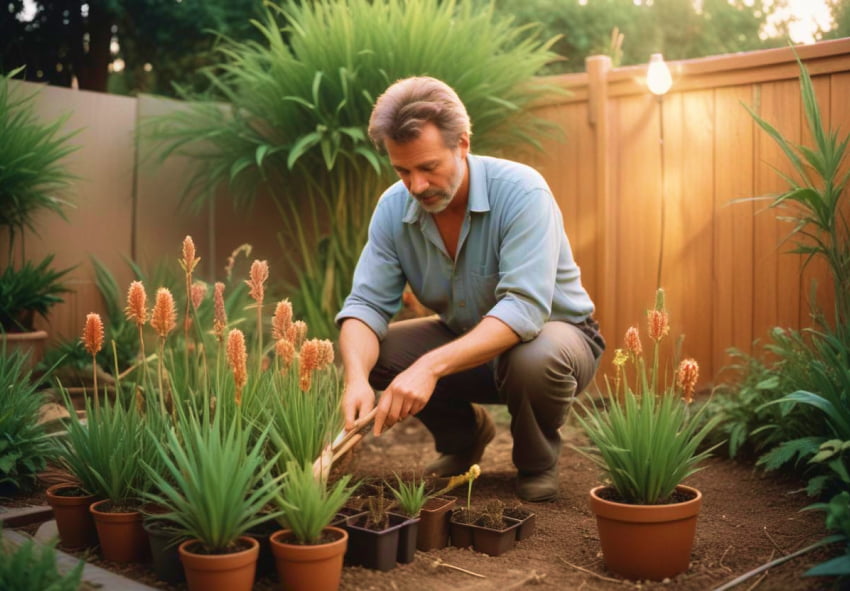
The planting of Kniphofia requires consideration of the garden layout, sunlight, and soil conditions. Following the appropriate planting steps can lead to a thriving display of these colorful flowers in your garden.
Choosing the Right Location
Selecting the ideal location for Kniphofia in your garden is crucial for their success. Choose a spot that receives at least six hours of sunlight daily to promote healthy growth and abundant flowering. Ensure the soil is well-draining and amend it with compost or sand if necessary to improve its structure and fertility. Additionally, consider the mature size of the Kniphofia variety you’re planting and provide adequate spacing to prevent overcrowding. Kniphofia can thrive in various garden settings, including borders, rock gardens, and along pathways, so plan your layout to showcase their unique, vibrant blooms effectively.
Best Time to Plant Kniphofia
The optimal time to plant Kniphofia is in the spring or early fall when temperatures are mild, allowing the plants to establish their root systems before extreme weather conditions. In colder climates, planting in the spring is advisable to prevent winter frost damage, while in milder regions, fall planting can help the plants settle before the onset of heat. Regardless of the planting season, ensure that the ground is not frozen or overly wet, as these conditions can hinder root development. Planting during these temperate times gives Kniphofia the best chance to adapt to their environment and prepare for a robust growing season.
How to Plant Kniphofia
Planting Kniphofia correctly sets the stage for healthy growth and vibrant blooms:
Choose the Right Location
- Select a spot in your garden that receives full sun to partial shade.
- Ensure the area has well-draining soil to prevent root rot.
Prepare the Soil
- Amend the soil with organic matter such as compost to improve fertility and drainage.
- Remove any weeds and debris from the planting area.
Dig the Holes
- For seeds, bulbs, or divisions, dig holes at an appropriate depth: about 2-3 inches for bulbs or divisions, and lightly cover seeds.
- Space the holes 18 to 24 inches apart to allow for plant growth.
Planting Kniphofia
- Place the bulbs or divisions in the hole, ensuring the crown is at or slightly above ground level.
- For seeds, sprinkle them lightly over the soil surface and cover with a thin layer of soil.
Water Thoroughly
- Water the newly planted Kniphofia well to settle the soil and eliminate air pockets.
- Maintain consistent moisture without waterlogging the soil, especially during the initial growth period.
Caring for Kniphofia
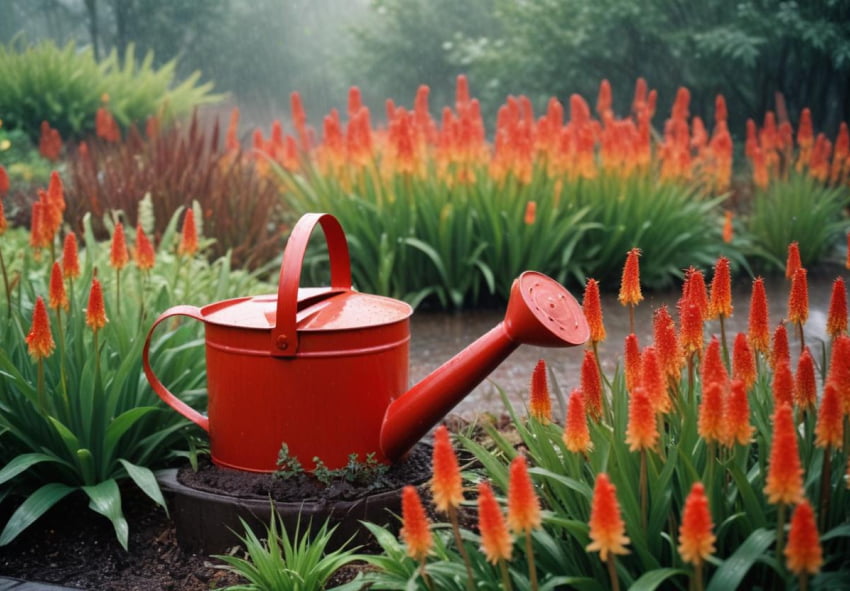
Caring for Kniphofia involves a combination of watering, fertilizing, pruning, and pest management. Proper care is essential for the health and longevity of the plant, ensuring it remains a striking feature in your garden for years to come. With consistent and mindful attention, Kniphofia will reward you with its vibrant blooms and lush foliage, enhancing the beauty of your outdoor space.
Watering Requirements
Kniphofia plants require consistent moisture, especially during the growing season, but they are sensitive to overwatering. Water the plants deeply once a week, allowing the soil to dry slightly between waterings. In areas with heavy rainfall or clay soils, reduce watering to prevent root rot. During hot, dry spells, you may need to increase the frequency of watering to keep the soil adequately moist. Be sure to avoid overhead watering, as wet foliage can encourage fungal diseases; instead, direct water to the base of the plant.
Fertilizing Kniphofia
Fertilize Kniphofia in early spring with a balanced, slow-release fertilizer to promote vigorous growth and flowering. Reapply the fertilizer in mid-summer to support the plant’s blooming cycle. Regular soil testing can help adjust fertilization based on nutrient deficiencies. If you notice yellowing leaves or stunted growth, it may indicate a lack of essential nutrients. Incorporating organic matter such as compost or well-rotted manure into the soil can also improve fertility and structure, providing a nutrient-rich environment for your Kniphofia.
Pruning and Maintenance
Pruning is essential to encourage new growth and extend the flowering period. Here are some tips for you:
- Deadheading Spent Flowers: Remove faded or spent flower spikes to encourage new blooms and maintain a tidy appearance. Cut the stem back to the base of the plant once flowering is complete.
- Seasonal Pruning: In late winter or early spring, remove any damaged or dead foliage to prepare the plant for new growth. Cut back old leaves to ground level to stimulate fresh growth.
- Divide Crowded Clumps: Every few years, divide overcrowded clumps in early spring to prevent congestion and promote healthy growth. Dig up the entire clump, separate it into smaller sections, and replant.
- Monitor for Pests and Diseases: Regularly inspect your Kniphofia for signs of pests or diseases, such as aphids or fungal infections. Treat any issues promptly with appropriate natural or chemical controls.
- Winter Protection: In colder climates, provide a layer of mulch over the root zone to protect against frost. Consider covering the plant with burlap or a protective cloth in extreme cold to prevent damage.
Propagating Kniphofia
Propagating Kniphofia allows gardeners to expand their collection and share this beautiful plant with others:
- Propagation by Division: Divide the plant every 3-4 years in spring or fall to prevent overcrowding and promote better flowering. Carefully dig up the clump, separate it into smaller sections, and replant them in prepared soil.
- Propagation by Seed: Sow Kniphofia seeds indoors 6-8 weeks before the last frost or directly in the garden after the danger of frost has passed. Keep the soil moist and warm to encourage germination, which usually occurs within 2-3 weeks.
Understanding the methods of propagation can help maintain the plant’s vigor and ensure the successful growth of new plants.
Pest and Disease Management
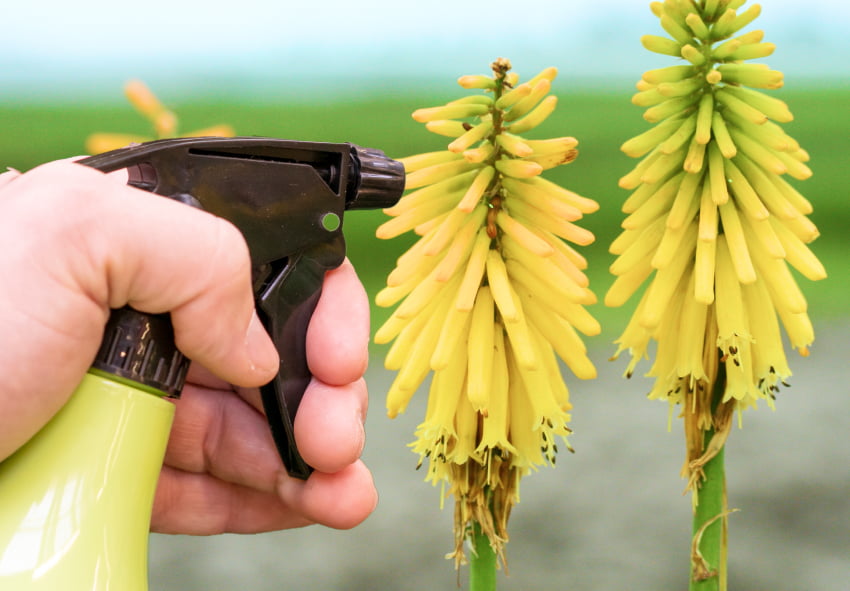
Proper management of pests and diseases for Kniphofia is crucial to maintaining healthy plants. Awareness and early detection can significantly reduce the impact on the plant’s health and appearance.
Common Pests Affecting Kniphofia
Kniphofia plants are generally hardy, but they can occasionally fall prey to pests such as aphids and slugs. Aphids are small, soft-bodied insects that suck plant sap, causing stunted growth and leaf curl. Slugs, on the other hand, are notorious for chewing on the foliage, which can be detrimental, especially to young plants.
To manage these pests, consider using natural methods such as introducing beneficial insects like ladybugs, which feed on aphids, or using copper tape or beer traps to deter slugs. If the infestation is severe, chemical pesticides or slug pellets can be used, but it’s essential to follow the product instructions carefully to minimize harm to beneficial insects and the environment.
Disease Prevention
Kniphofia is relatively disease-resistant, but it can be susceptible to fungal infections such as rust and leaf spots, especially in humid conditions. These diseases can cause unsightly blemishes on the foliage and reduce the plant’s vigor.
To prevent these issues, ensure proper air circulation around the plants by spacing them adequately and pruning dead or crowded leaves. Water the plants at the base to avoid wetting the foliage, which can encourage fungal growth. If an infection occurs, remove and destroy the affected parts and consider applying a suitable fungicide to control the spread.
Using Kniphofia in Garden Design
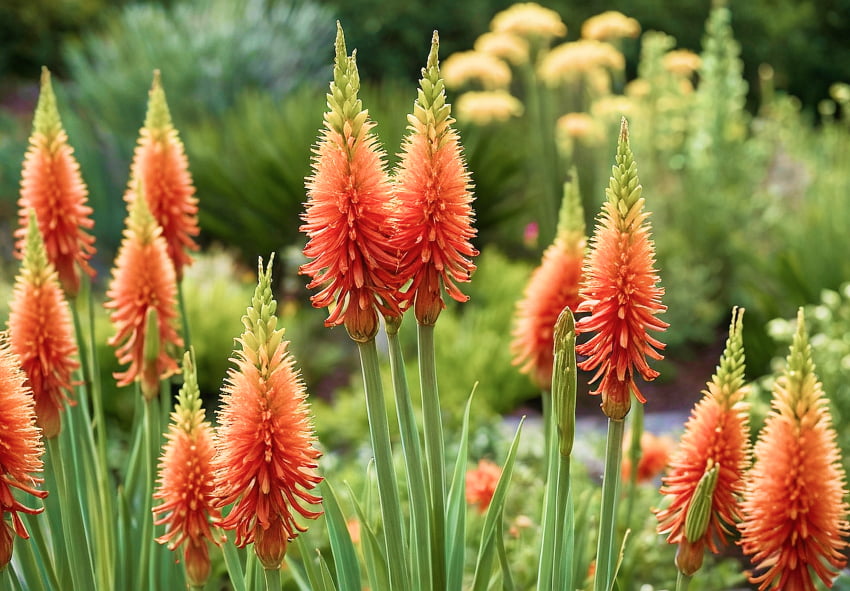
Kniphofia’s bold structure and vibrant colors make it a fantastic focal point in garden design. Whether used as a solitary feature or combined with other plants, Kniphofia can add a dramatic flair to your garden landscape.
Landscaping with Kniphofia
Incorporate Kniphofia into your garden by planting them in clusters for a striking visual impact. These plants pair well with grasses and other perennials is different design decisions:
- Dramatic Focal Points: Use Kniphofia as a striking centerpiece in garden beds or borders, thanks to their vibrant flower spikes and tall stature. Plant them in groups of three or more to create a bold visual statement.
- Colorful Backdrops: Position Kniphofia at the back of a mixed border to provide a colorful backdrop for shorter plants. Combine with plants that have contrasting foliage or flower colors for a dynamic effect.
- Wildlife-Friendly Gardens: Include Kniphofia in wildlife gardens to attract pollinators like bees and butterflies, which are drawn to their nectar-rich flowers. Pair with other pollinator-friendly plants to enhance the garden’s ecological value.
- Complementary Plantings: Pair Kniphofia with grasses, echinacea, and sedums for a diverse and textured planting scheme. Use plants with similar water and sunlight needs to ensure a cohesive and healthy garden.
- Seasonal Interest: Combine Kniphofia with other perennials that bloom at different times to ensure year-round interest in the garden. Use early spring and late summer bloomers to complement the mid-summer flowering period of Kniphofia.
Kniphofia in Containers
Growing Kniphofia in pots and planters offers flexibility and allows gardeners to enjoy these vibrant flowers in smaller spaces such as patios and balconies. When planting in containers, choose a pot with good drainage and use a high-quality potting mix to provide the necessary nutrients.
The advantages of container gardening with Kniphofia include easier mobility, the ability to control soil conditions, and protection from pests and diseases that commonly affect garden-grown plants. Ensure the containers receive adequate sunlight and water the plants regularly, but avoid waterlogging the soil.
Benefits of Growing Kniphofia
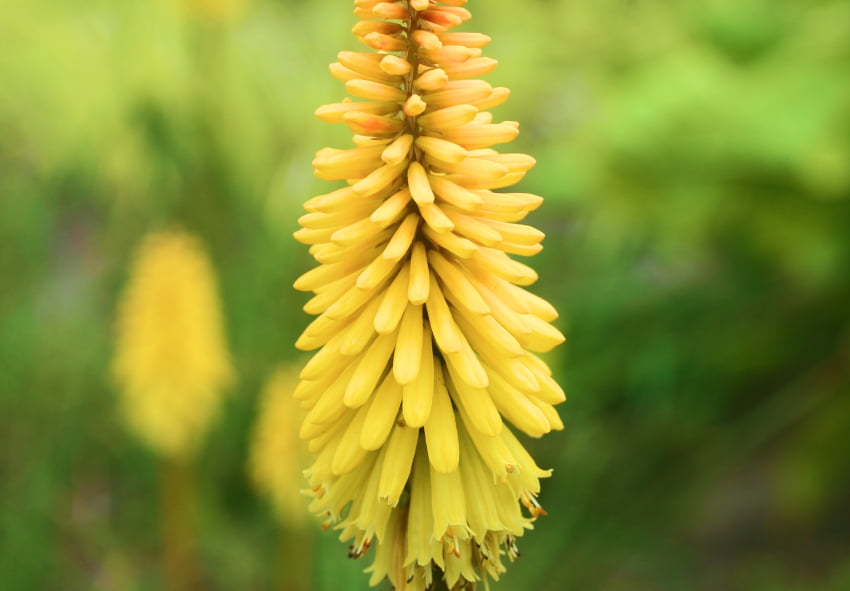
Kniphofia, also known as Red Hot Poker, is not only visually stunning but also a versatile addition to any garden. Its unique flower spikes and vibrant colors make it a popular choice among gardeners. Beyond aesthetics, growing Kniphofia offers ecological benefits and adaptability to various garden settings.
Special Features of Kniphofia
Kniphofia is a standout in any garden due to its unique characteristics. The plant is renowned for its tall, torch-like flower spikes that bloom in vibrant shades of red, orange, and yellow. This striking appearance adds vertical interest and a splash of color to any landscape.
In addition to its visual appeal, Kniphofia has a long blooming period, providing a prolonged display of color from early summer to fall. This extended flowering season makes Kniphofia a valuable addition to the garden, offering beauty and interest throughout the growing season.
Conclusion
Growing Kniphofia can transform your garden with its vibrant colors and unique form. By understanding the proper care and planting techniques, you can enjoy a stunning display of Red Hot Pokers in your garden. Experiment with different varieties and explore creative landscaping ideas to make the most of this versatile and attractive plant.
Frequently Asked Questions (FAQs) about Kniphofia
1. How often should I water my Kniphofia plants?
Kniphofia requires consistent moisture but is sensitive to overwatering. Water deeply once a week during the growing season, allowing the soil to dry slightly between waterings. Adjust based on local rainfall and soil type.
2. Can I order Holland Kniphofia from your online store?
Certainly! At our online store Dutch-bulbs.com, we offer a wide selection of Kniphofia plants, including varieties sourced from Holland. You can browse our inventory to find Holland Kniphofia plants that suit your preferences and gardening needs.
3. What are the common pests and diseases affecting Kniphofia?
Common pests include aphids and slugs, while diseases can involve fungal infections like powdery mildew. Regularly inspect your plants, use appropriate pest control methods, and ensure proper air circulation to prevent disease.
4. Can Kniphofia be grown in containers?
Yes, many Kniphofia varieties are suitable for container gardening, especially dwarf types. Ensure the container has good drainage and use a high-quality potting mix to support healthy growth.
5. How can I propagate Kniphofia?
Kniphofia can be propagated through division and seed. For division, split established clumps in early spring or fall. For seeds, sow them indoors before the last frost or directly into the garden in spring.
Published: 27.08.2024

